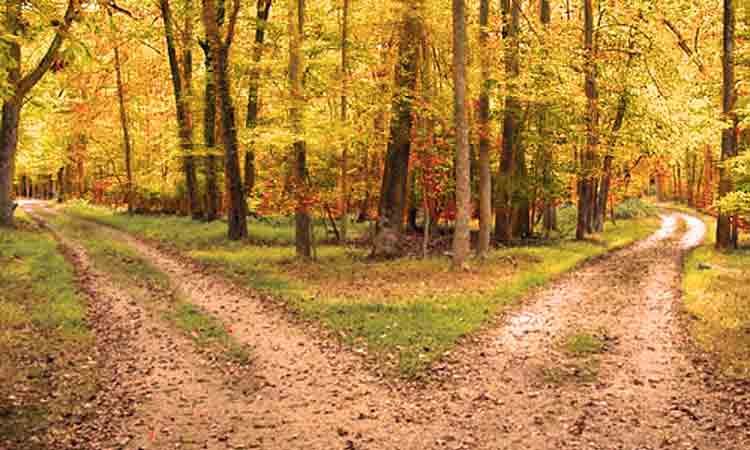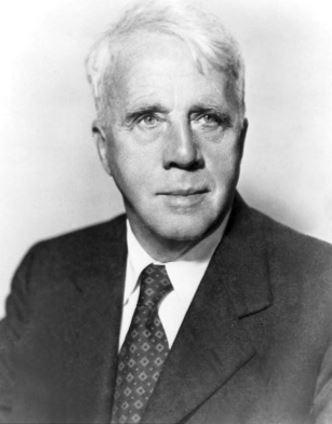Poem-1
The Road Not Taken
By Robert Frost

The Road Not Taken Poem Introduction
The road represents our life in the poem 'The Road Not Taken.' According to the poet, the path we do not choose in our lives is the road not taken. He expresses his feelings about the decision he made in the past. Our future, our destination, is determined by the path we have chosen. The important message that the poet wishes to convey is that the decisions we make have an impact on our future, and if we make a bad decision, we will regret it but will be unable to reverse it. As a result, we must take caution when making decisions.
The Road Not Taken Poem Summary
According to the poet, he was walking down the road when he came to a fork. He could only walk on one of the paths. He analysed for some time before deciding on the best course of action. He examined them to determine which was the better option, then chose the one that appeared to be less walked over. He saved the other one for another day, even though he knew he'd never get the chance to walk over it. He'd go further down the chosen path and wouldn't be able to turn back. As he walked down the chosen path, he realised how similar the two paths were. He believed that the decision he made would determine his future.
The Road Not Taken Poem Explanation
Two roads diverged in a yellow wood,
And sorry I could not travel both
And be one traveller, long I stood
And looked down one as far as I could
To where it bent in the undergrowth;
- diverged: separated and took a different direction
- yellow wood: a forest with decomposing leaves
- undergrowth: dense growth of plants and bushes means the forest)
Once upon a time, the poet was walking down a road when he came to a cross road; there were two different paths and he had to choose one of them. The poet says that because he was only one person, he could only travel on one road. He had to choose between these two options. Yellow wood denotes a forest with worn-out leaves that have turned yellow in colour – the season of autumn. It represents a crowded world where people have been living for a long time. They stand in for people who are older than the poet. The poet remained standing and carefully examined the path as far as he could see it.
He wanted to know how the path was before taking it. Was it appropriate for him? He could see the path until it curved, at which point it was covered in trees and hidden. It happens in our lives when we have choices, when we have alternatives, but we have to choose only one of them, when we take time to consider the pros and cons, whether it is suitable for us or not, and only then do we make a decision on which path we should take.
Then took the other, just as fair
And having perhaps the better claim,
Because it was grassy and wanted wear;
Though as for that the passing there
Had worn them really about the same.
- fair: As good as the other one,
- claim: Better option
- grassy: unused
- wanted wear: had not been used
The poet spent a long time looking at one path to see if it was the right path for him, and then he decided and began walking on another path because he felt that both paths were equally good. He says it's just as fair, so he decided both paths were equally good and began walking on one of them. He continues, "Perhaps he felt that the path was better for him, so he chose it because it had grass on it, indicating that it was unused." Because there had not been many people walking on this path previously, it was grassy. 'And wanted wear' denotes that it was not walked over by a large number of people. After walking for a while on the path, he realised that both paths had been wormed out in the same way. Both paths were worn out and similar. Even in our daily lives, we can choose any path or option, but they all have the same benefits, drawbacks, problems, and challenges that we must face. We believe we are making a better decision, but this is not the case.
And both that morning equally lay
In leaves, no step had trodden black.
Oh, I kept the first for another day!
Yet knowing how way leads on to way,
I doubted if I should ever come back.
- trodden means walked over.
According to the poet, both paths were similar that morning. Both had leaves on them and had not been stepped on because they were still green. He decided to take one path that day and leave the other for another, despite the fact that he knew that one path leads to another. He knew he couldn't change his mind about the decision he'd made. Similarly, once we choose an option in our lives, we must stick with that option and never have the opportunity to return and take the other option that we had left earlier.
I shall be telling this with a sigh
Somewhere ages and ages hence;
Two roads diverged in a wood, and I —
I took the one less travelled by,
And that has made all the difference.
- sigh: deep breath
- hence: here, in the future
He says that in the future, he will take a deep breath and say that once upon a time, he had reached a point in life where he had two options, and he chose the road that had been travelled by fewer people. His future was determined by that decision. Similarly, when you are older, you will recall that once upon a time, when you were young, you had two options. You became what you became as a result of the decision you made. This is a strong message for all students: be wise and cautious when making decisions from the options available to you in life, because your future is dependent on the decisions you make today.
The Road Not Taken Poem Literary Devices
1. Rhyme Scheme: abaab
2. Symbolism: two roads that represent two or more choices in our life
3. Anaphora: ‘and’ repeated at the beginning of lines 2, 3 and 4
4. Alliteration: Wanted Wear ‘w’ sound is repeating
- ‘first for’ – ‘f’ sound is repeating
- ‘though, that’- ‘th’ sound is repeating
5. Repetition: ‘Ages’ is repeated. ‘Two roads diverged in a wood’- this sentence is repeated in stanzas 1 and 4.
About the Poet

Robert Frost was an American poet who lived from 1874 to 1963. His work was first published in England before being released in the United States. He is well-known for his realistic depictions of rural life and command of the American language. He established himself as one of the United States' few "public literary figures, almost an artistic institution."

 ACERISE INDIA
ACERISE INDIA
